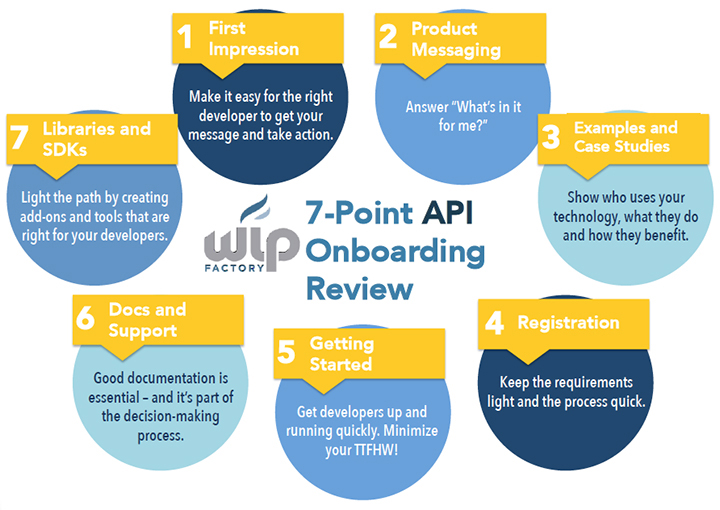In our webinar last week, Carlo Longino, VP of Developer Program Services at WIP Factory and Richard Mendis, Co-Founder and CMO at AnyPresence shared practical advice related to API strategy and technical onboarding.
As part of his presentation. Carlo described an excellent 7 Point API Onboarding Review that we believe is worth summarizing and sharing with you.

1 – First Impression
Make it easy for the right Developer to get your message and take action. Understand who the developers are, and what is the timing and context around their needs. Define the segments you want to target and answer those questions: Who are they? What problem are we solving for them? Then, make it clear for them that this tool was built for them.
2 – Product Messaging
Answer that question for the developer: “What is in it for me? How is this going to help me achieve my goals?” Communicate why the developer should use your product and why your product is better than the competition. Expand on the value proposition and why your APIs deserve a try. This is where it is not enough to just list all the features but also explain the benefits for your developers.
3 – Examples and Case Studies
Show who use your technology, what they do with it and how they benefit from it. By demonstrating how your APIs are working rather than just telling them, it will help you build understanding and credibility around your APIs. Also, showing how their contemporaries and colleagues are using your products is very persuasive with developers; they highly value other people experiences.
4 – Registration
Keep the registration requirements light and the process quick. In the awareness stage, your priority is to get the developer to start using your APIs so keep the amount of information you collect to a bare minimum. Being able to use the API, the SDK and the code is part of the decision making process and wanting to try that API doesn’t automatically mean they are ready to purchase. Also, when developers start the registration process, they are merely showing their intent to use the API. However, if they have to wait 24h to be approved, they will spend that time to find other alternatives. Make sure you don’t hinder their momentum and provide quick and easy access to your APIs.
5 – Getting Started
Get developers up and running quickly and minimize their TTFHW (Time To First Hello World). To do so, you will need to create a bulletproof Start Guide providing step-by-step instructions to get started. Ideally, you provide the developer with a fully working sample app that matches their specific need based on client-slide platform, use case, and sample data. This will significantly lower your “TTFHW”. Then, measure how quickly developers start to see result. It is critical that you look at the complete process from beginning to end including time to sign up and register, time to find the appropriate information and time to test. We recommend that you go through the entire process yourself or even better, that you observe a developer doing so. You will then be able to identify and remove the roadblocks they faced when starting to use your APIs.
6 – Documentation and Support
Good documentation and support are essential and it is part of the decision making process. When something goes wrong, they want to get their questions answered quickly. So check that you are answering all questions on Stackoverflow and popular forums where developers go, make sure those answers can be easily found. If you provide documentation, offer it in a searchable format and don’t hide behind logins. Don’t forget to offer code samples and demo. This is not just about post-sales support but it is also an integral part of the decision making process. And don’t try to reinvent the wheel by creating a forum on your own site; instead just go where the developers already go.
7 – Libraries and SDKs
Light the path by creating add-ons and tools that are right for your developers. Make it easier for them by giving them relevant libraries and SDKs, with appropriate comments and instructions, that they can integrate in their products. Integrate with the tools they are already using. Link to outside libraries and open-source projects that exist. A fully working sample app that actually shows developers best practices on how to consume your libraries and SDKs would be preferred. Create currency with your developer community, as well as support developer. This way, you will show that their work is important to you.
For more information, you can visit the WIP Factory website. If you want to watch the webinar replay, you can access it on the AnyPresence Website.